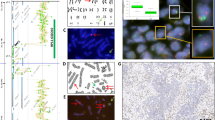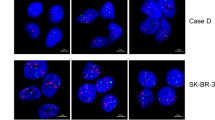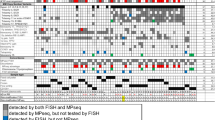Abstract
Screening for specific genetic aberrations by fluorescence and chromogenic in situ hybridization (fluorescence in situ hybridization (FISH) and chromogenic in situ hybridization (CISH)) can reveal associations with tumor types or subtypes, cellular morphology and clinical behavior. FISH and CISH methodologies are based on the specific annealing (hybridization) of labeled genomic sequences (probes) to complementary nucleic acids within fixed cells to allow their detection, quantification and spatial localization. Formalin-fixed paraffin embedded (FFPE) material is the most widely available source of tumor samples. Increasingly, tissue microarrays (TMAs) consisting of multiple cores of FFPE material are being used to enable simultaneous analyses of many archival samples. Here we describe robust protocols for the FISH and CISH analyses of genetic aberrations in FFPE tissue, including TMAs. Protocols include probe preparation, hybridization and detection. Steps are described to reduce background fluorescence and strip probes for repeat FISH analyses to maximize the use of tissue resources. The basic protocol takes 2–3 d to complete.
This is a preview of subscription content, access via your institution
Access options
Subscribe to this journal
Receive 12 print issues and online access
$259.00 per year
only $21.58 per issue
Buy this article
- Purchase on Springer Link
- Instant access to full article PDF
Prices may be subject to local taxes which are calculated during checkout



Similar content being viewed by others
References
Hanahan, D. & Weinberg, R.A. The hallmarks of cancer. Cell 100, 57–70 (2000).
Mitelman, F., Johansson, B. & Mertens, F. The impact of translocations and gene fusions on cancer causation. Nat. Rev. Cancer 7, 233–245 (2007).
Slater, O. & Shipley, J. Clinical relevance of molecular genetics to paediatric sarcomas. J. Clin. Pathol. 60, 1187–1194 (2007).
Hussain, S.A., Palmer, D.H., Spooner, D. & Rea, D.W. Molecularly targeted therapeutics for breast cancer. BioDrugs 21, 215–224 (2007).
Shipley, J. & Fisher, C. Chromosome translocations in sarcomas and the analysis of paraffin-embedded material. J. Pathol. 184, 1–3 (1998).
Lambros, M.B., Natrajan, R. & Reis-Filho, J.S. Chromogenic and fluorescent in situ hybridization in breast cancer. Hum. Pathol. 38, 1105–1122 (2007).
Bramwell, N.H. & Burns, B.F. The effects of fixative type and fixation time on the quantity and quality of extractable DNA for hybridization studies on lymphoid tissue. Exp. Hematol. 16, 730–732 (1988).
Srinivasan, M., Sedmak, D. & Jewell, S. Effect of fixatives and tissue processing on the content and integrity of nucleic acids. Am. J. Pathol. 161, 1961–1971 (2002).
Ben-Ezra, J., Johnson, D.A., Rossi, J., Cook, N. & Wu, A. Effect of fixation on the amplification of nucleic acids from paraffin-embedded material by the polymerase chain reaction. J. Histochem. Cytochem. 39, 351–354 (1991).
Argani, P., Zakowski, M.F., Klimstra, D.S., Rosai, J. & Ladanyi, M. Detection of the SYT-SSX chimeric RNA of synovial sarcoma in paraffin-embedded tissue and its application in problematic cases. Mod. Pathol. 11, 65–71 (1998).
Zsikla, V., Baumann, M. & Cathomas, G. Effect of buffered formalin on amplification of DNA from paraffin wax embedded small biopsies using real-time PCR. J. Clin. Pathol. 57, 654–656 (2004).
Williamson, D. et al. Relationship between MYCN copy number and expression in rhabdomyosarcomas and correlation with adverse prognosis in the alveolar subtype. J. Clin. Oncol. 23, 880–888 (2005).
van Dijk, M.C. et al. Multiplex ligation-dependent probe amplification for the detection of chromosomal gains and losses in formalin-fixed tissue. Diagn. Mol. Pathol. 14, 9–16 (2005).
Kononen, J. et al. Tissue microarrays for high-throughput molecular profiling of tumor specimens. Nat. Med. 4, 844–847 (1998).
Gray, J.W. et al. Molecular cytogenetics: diagnosis and prognostic assessment. Curr. Opin. Biotechnol. 3, 623–631 (1992).
Tanner, M. et al. Chromogenic in situ hybridization: a practical alternative for fluorescence in situ hybridization to detect HER-2/neu oncogene amplification in archival breast cancer samples. Am. J. Pathol. 157, 1467–1472 (2000).
Lambros, M.B. et al. Unlocking pathology archives for molecular genetic studies: a reliable method to generate probes for chromogenic and fluorescent in situ hybridization. Lab. Invest. 86, 398–408 (2006).
Laakso, M., Tanner, M. & Isola, J. Dual-colour chromogenic in situ hybridization for testing of HER-2 oncogene amplification in archival breast tumours. J. Pathol. 210, 3–9 (2006).
Shipley, J. Putting the colours into chromogenic in situ hybridization (CISH). J. Pathol. 210, 1–2 (2006).
Lu, Y.J. et al. Dual colour fluorescence in situ hybridization to paraffin-embedded samples to deduce the presence of the der(X)t(X;18)(p11.2;q11.2) and involvement of either the SSX1 or SSX2 gene: a diagnostic and prognostic aid for synovial sarcoma. J. Pathol. 187, 490–496 (1999).
Birdsall, S., Osin, P., Lu, Y.J., Fisher, C. & Shipley, J. Synovial sarcoma specific translocation associated with both epithelial and spindle cell components. Int. J. Cancer 82, 605–608 (1999).
Schraml, P. et al. Tissue microarrays for gene amplification surveys in many different tumor types. Clin. Cancer Res. 5, 1966–1975 (1999).
Brown, L.A. & Huntsman, D. Fluorescent in situ hybridization on tissue microarrays: challenges and solutions. J. Mol. Histol. 38, 151–157 (2007).
Baschong, W., Suetterlin, R. & Laeng, R.H. Control of autofluorescence of archival formaldehyde-fixed, paraffin-embedded tissue in confocal laser scanning microscopy (CLSM). J. Histochem. Cytochem. 49, 1565–1572 (2001).
Capodieci, P. et al. Gene expression profiling in single cells within tissue. Nat. Methods 2, 663–665 (2005).
Sambrook, J., Fritsch, E. & Maniatis, T. Molecular cloning: A Laboratory Manual Vol. 1–3 (Cold Spring Harbor Laboratory Press, Cold Spring Harbor, New York, 1989).
Smedley, D. et al. Characterization of chromosome 1 abnormalities in malignant melanomas. Genes Chromosomes Cancer 28, 121–125 (2000).
Kallioniemi, O.P., Wagner, U., Kononen, J. & Sauter, G. Tissue microarray technology for high-throughput molecular profiling of cancer. Hum. Mol. Genet. 10, 657–662 (2001).
Bayani, J. & Squire, J.A. Application and interpretation of FISH in biomarker studies. Cancer Lett. 249, 97–109 (2007).
Shipley, J. et al. Interphase fluorescence in situ hybridization and reverse transcription polymerase chain reaction as a diagnostic aid for synovial sarcoma. Am. J. Pathol. 148, 559–567 (1996).
Aubele, M. et al. Comparative FISH analysis of numerical chromosome 7 abnormalities in 5-micron and 15-micron paraffin-embedded tissue sections from prostatic carcinoma. Histochem. Cell Biol. 107, 121–126 (1997).
Attard, G. et al. Duplication of the fusion of TMPRSS2 to ERG sequences identifies fatal human prostate cancer. Oncogene 27, 253–263 (2007).
Clark, J. et al. Complex patterns of ETS gene alteration arise during cancer development in the human prostate. Oncogene (2007). Oct 8 (Epub ahead of print).
Acknowledgements
The authors thank Sian Rizzo and Neil Goddard for critical reviewing of the manuscript.
Author information
Authors and Affiliations
Corresponding author
Rights and permissions
About this article
Cite this article
Summersgill, B., Clark, J. & Shipley, J. Fluorescence and chromogenic in situ hybridization to detect genetic aberrations in formalin-fixed paraffin embedded material, including tissue microarrays. Nat Protoc 3, 220–234 (2008). https://doi.org/10.1038/nprot.2007.534
Published:
Issue Date:
DOI: https://doi.org/10.1038/nprot.2007.534
This article is cited by
-
European recommendations and quality assurance for cytogenomic analysis of haematological neoplasms
Leukemia (2019)
-
Aspirin and NSAID use in association with molecular subtypes of prostate cancer defined by TMPRSS2:ERG fusion status
Prostate Cancer and Prostatic Diseases (2016)
-
Epigenomic profiling of prostate cancer identifies differentially methylated genes in TMPRSS2:ERG fusion-positive versus fusion-negative tumors
Clinical Epigenetics (2015)
-
A meta-analysis of 87,040 individuals identifies 23 new susceptibility loci for prostate cancer
Nature Genetics (2014)
Comments
By submitting a comment you agree to abide by our Terms and Community Guidelines. If you find something abusive or that does not comply with our terms or guidelines please flag it as inappropriate.



